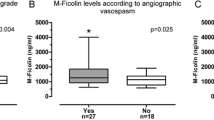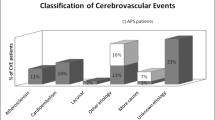Summary
Delayed ischaemic deficits due to cerebral vasospasm contribute to the high morbidity and mortality rates associated with subarachnoid haemorrhage. We evaluated the usefulness of measuring anti-phospholipid antibodies (aPLs) for prediction of the occurrence of symptomatic vasospasm and the outcome after subarachnoid haemorrhage. 32 consecutive patients with subarachnoid haemorrhage due to ruptured cerebral aneurysms were studied. They were admitted and operated on within 72 hours after the onset of subarachnoid haemorrhage. aPLs such as lupus anticoagulants, anti-cardiolipin IgG and anti-cardiolipin IgM were measured repeatedly after admission. Furthermore, platelet count, platelet aggregability and plasma platelet factor 4 were also measured. Eleven among the 32 patients (34.4%) showed positive in the examination for aPLs. Although aPLs could not predict symptomatic vasospasm, once symptomatic vasospasm occurred, patients with aPLs frequently demonstrated cerebral infarction and there-fore their outcome was worse. aPLs were associated with a severe initial clinical grade and SAH grade on CT scan. Therefore it may explain the association of aPLs with worse outcome. aPLs were detected between 1 and 7 days. Four of 6 patients (67%) with aPLs became negative between 7 and 13 days after subarachnoid haemorrhage. The mechanism of transient aPLs is unclear but it is more likely to occur in the severer grade patients. The reduction in platelet count, the increased platelet aggregability, and the increased plasma platelet factor 4 concentration were also observed in aPLs-positive patients with symptomatic vasospasm.
Similar content being viewed by others
References
Ameriso SF, Wong VLY, Ishii H, Quismorio FP, Giannotta SL, Meiselman HJ, Fisher M (1992) Hematogenous factor and prediction of delayed ischemic deficit after subarachnoid hemorrhage. Stroke 23: 1404–1409
Bowie EJW, Thompson JH, Cascuzzi PA, Owen GA (1963) Thrombosis in systemic lupus erythematosus despite circulating anticoagulants. J Lab Clin Med 62: 416–430
Carreras LO, Defreyn G, Machin SJ, Vermylen J, Deman R, Spitz B, Van Assche A (1981) Arterial thrombosis, intrauterine death and ‘lupus’ anticoagulant: detection of immunoglobulin interfering with prostacyclin formation. Lancet 31: 244–246
Chan RC (1984) The role of the prostacyclin-thromboxane system in cerebral vasospasm following induced subarachnoid hemorrhage in the rabbit. J Neurosurg 61: 1120–1128
Comp PC, DeBault LE, Esmon NL, Esmon CT (1983) Human thrombomodulin is inhibited by IgG from two patients with non-specific anticoagulants. Blood 62 [Suppl 1]: 299a (Abstract)
Cosgriff TM, Martin BA (1981) Low functional and high anti-genic antithrombin III level in a patient with the lupus anticoagulant and recurrent thrombosis. Artritis Rheum 24: 94–96
Elias M, Eldor A (1984) Thromboembolism in patients with the lupus-type circulating anticoagulant. Arch Intern Med 144: 510–515
Fein JM, Flow WJ, Cohan SL, Parkhurst J (1974) Sequential changes of vascular ultrastructure in experimental vasospasm. J Neurosurg 41: 49–58
Fisher CM, Kistler JP, Davis JM (1980) Relation of cerebral terized tomographic scanning. Neurosurgery 6: 1–9
Fisher M, McGehee W (1985) Cerebral infarct, TIA and lupus inhibitor. Neurology 36: 1234–1237
Freyssinet JM, Wiesel ML, Gauch J, Boneu B, Cazenave J-P (1986) An IgM lupus anticoagulant that neutralizes the enhancing effect of phospholipid on purified endothelial thrombomodulin activity. A mechanism for thrombosis. Thromb Haemost 53: 309–313
Fukumori T, Tani E, Maeda Y, Sukenaga A (1984) Effect of selective inhibitor of thromboxane A2 synthetase on experimental cerebral vasospasm. Stroke 15: 306–311
Gastineau DA, Kazmier FJ, Nicholos WL, Bowie EJW (1985) Lupus anticoagulant: an analysis of the clinical and laboratory features of 219 cases. Am J Hematol 19: 265–275
Goto O, Tamura A, Nihei H, Manaka S, Kirino T, Sano K (1993) Vasospasm and its outcome after early surgery for ruptured cerebral aneurysms: relation with the clinical grade based on the Glasgow coma scale. Neurol Surg 21: 221–226
Harris EN, Gharvani AE, Hughes GRV (1985) Anti-phospholipid antibodies. Clin Rheum Dis 11: 591–609
Hirashima Y, Hayashi N, Endo S, Takaku A (1993) Sequential changes of the platelet count in patients with symptomatic vasospasm after subarachnoid hemorrhage. Neurol Med Chir (Tokyo) 33: 220–224
Ingram S, Goodnight SH, Bennett RM (1987) An unusual syndrome of a devastating noninflammatory vascuolopathy associated with anticardiolipin antibodies: report of two cases. Arthritis Rheum 30: 1167–1172
Jannet B, Bond M (1975) Assessment of outcome after severe brain damage. A practical scale. Lancet 1: 480–491
Juvela S, Kaste M, Hillbom M (1990) Effect of nimodipine on platelet function in patients with subarachnoid hemorrhage. Stroke 21: 1283–1288
Kassell NF, Sasaki T, Colohan ART, Nazar G (1985) Cerebral vasospasm following aneurysmal subarachnoid hemorrhage. Stroke 16: 562–572
Kelly PJ, Gorten RJ, Brossman RG, Eisenberg HM (1977) Cerebral perfusion, vascular spasm and outcome in patients with ruptured intracranial aneurysms. J Neurosurg 47: 44–49
Mueh JR, Herbst KD, Rapaport SI (1980) Thrombosis in patients with the lupus anticoagulant. Ann Intern Med 92: 156–159
Ohkuma H, Suzuki S, Kimura M, Sobata E (1991) Role of platelet function in symptomatic cerebral vasospasm following aneurysmal subarachnoid hemorrhage. Stroke 22: 854–859
Petruk KG, Weir BK, Overton TR, Marriott MR, Grace MG (1974) The effect of graded hypocapnia and hypercapnia on regional cerebral blood flow and cerebral vessel caliber in the rhesus monkey: study of cerebral hemodynamics following subarachnoid hemorrhage and traumatic internal carotid spasm. Stroke 5: 230–246
Sanfelippo MJ, Drayna C (1982) Prekallikrein inhibition associated with the lupus anticoagulant. A mechanism of thrombosis. Am J Clin Pathol 77: 275–279
Shapiro SS, Thiagarajan P (1982) Lupus anticoagulants. In: Spaet TH (ed) Progress in hemostasis and thrombosis, Vol VI. Grune and Stratton, Orlando, pp 263–285
Smith RR, Clower BR, Peeler DF, Yoshioka J (1983) The angiopathy of subarachnoid hemorrhage: angiographic and morphologic correlates. Stroke 14: 240–245
Suzuki S, Kimura M, Souma M, Ohkima H, Shimizu T, Iwabuchi T (1990) Cerebral microthrombosis in symptomatic cerebral vasospasm. A quantitative histological study in autopsy cases. Neuro Med Chir (Tokyo) 30: 309–316
Teasdale GM (1988) A universal subarachnoid haemorrhage scale: report of a committee of the World Federation of Neurosurgical Societies. J Neurol Neurosurg Psychiatry 51: 1457–1463
Yamagata S, Kikuchi H, Ihara I, Nagata I, Morooka Y, Naruo Y, Koizumi T, Hashimoto K, Minamikawa J, Miyamoto S, Mitsuno K, Matsumoto M, Yamazoe N, Akiyama Y (1988) Cerebral blood flow as a prognostic indication in subarachnoid hemorrhage. Neuro Med Chir (Tokyo) 28: 333–339
Author information
Authors and Affiliations
Rights and permissions
About this article
Cite this article
Hirashima, Y., Kurimoto, M., Tsukamoto, E. et al. Anti-phospholipid antibodies and cerebral vasospasm following subarachnoid haemorrhage. Acta neurochir 135, 191–197 (1995). https://doi.org/10.1007/BF02187767
Issue Date:
DOI: https://doi.org/10.1007/BF02187767




